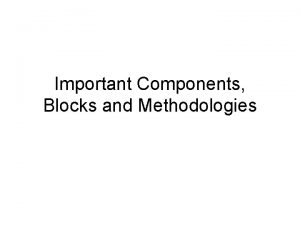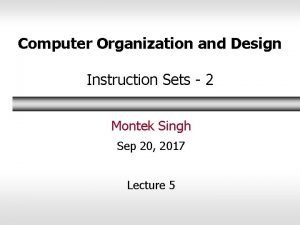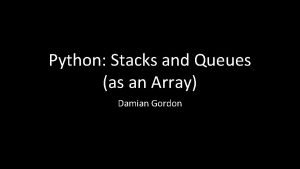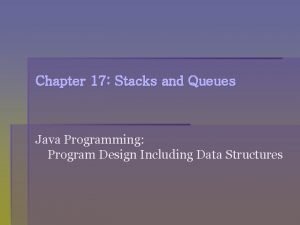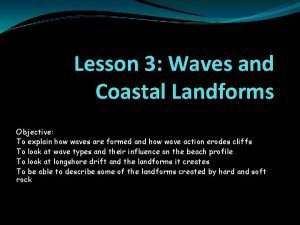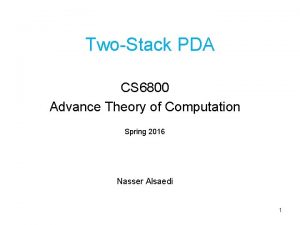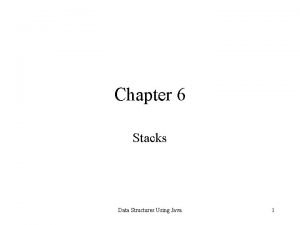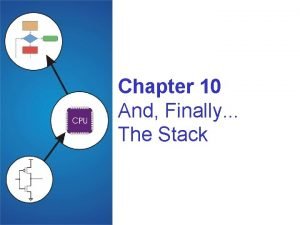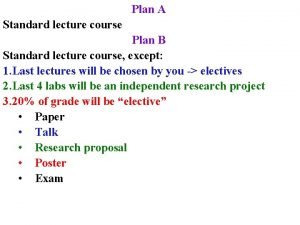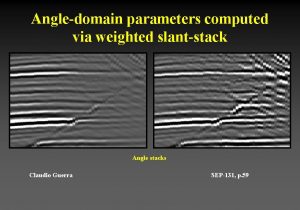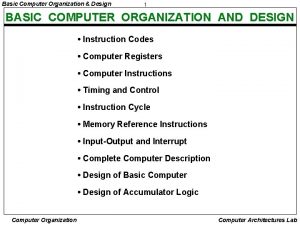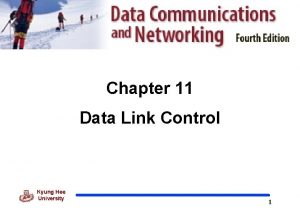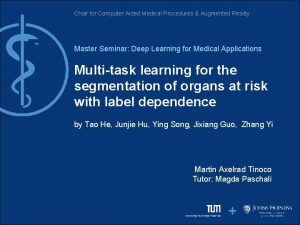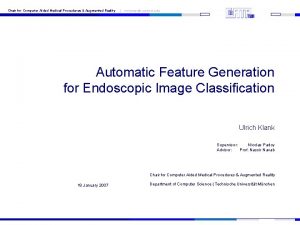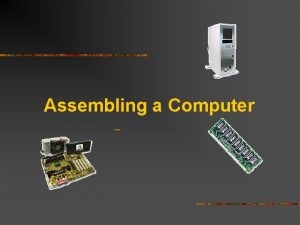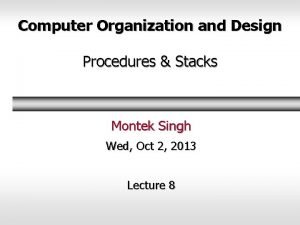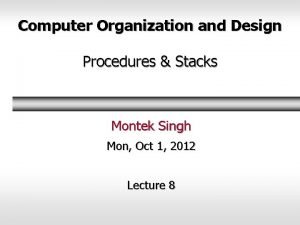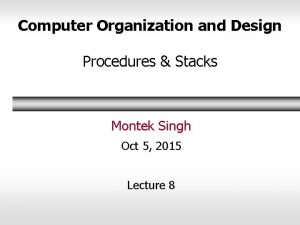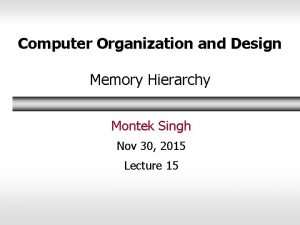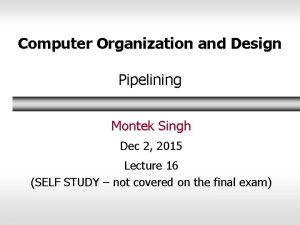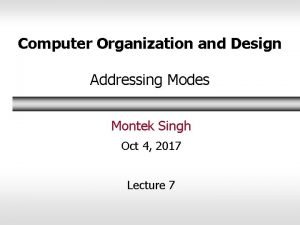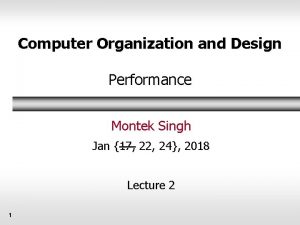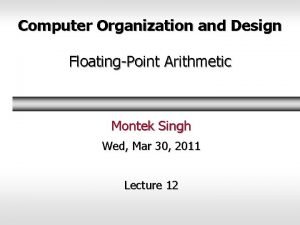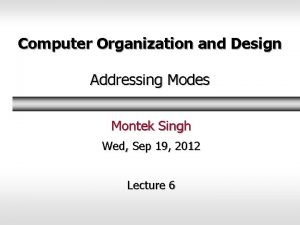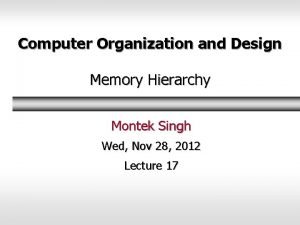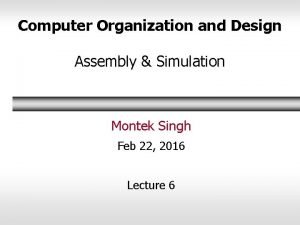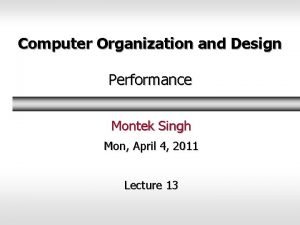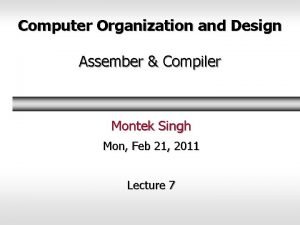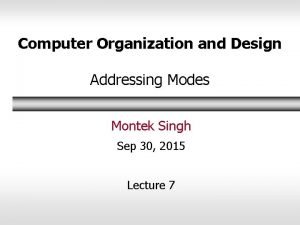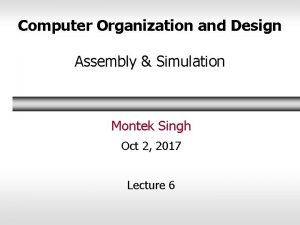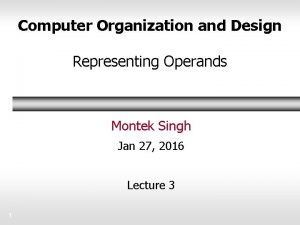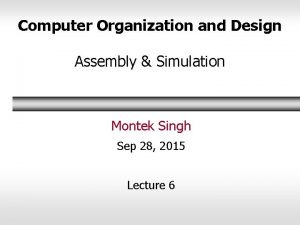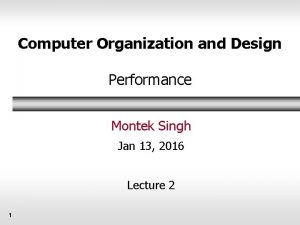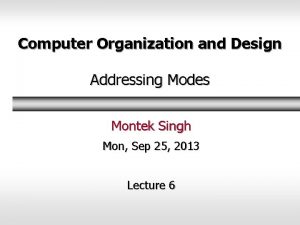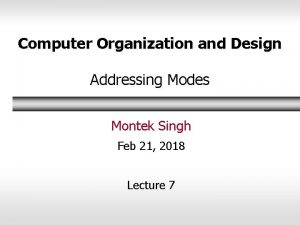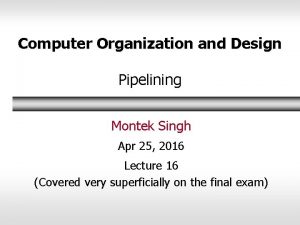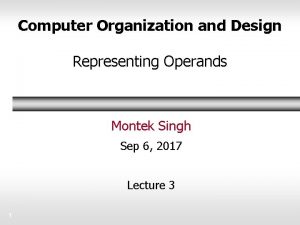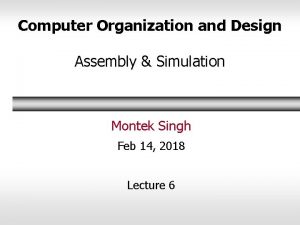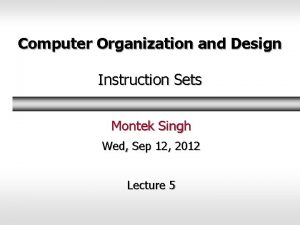Computer Organization and Design Procedures Stacks Montek Singh















![Stack Management Primitives ALLOCATE k: reserve k WORDS of stack Reg[SP] = Reg[SP] - Stack Management Primitives ALLOCATE k: reserve k WORDS of stack Reg[SP] = Reg[SP] -](https://slidetodoc.com/presentation_image_h2/6c44c0de777bf4a05adccc45df4a1e3d/image-16.jpg)














- Slides: 30

Computer Organization and Design Procedures & Stacks Montek Singh Feb 29, Mar 7 Lecture 8

Today ã Procedures l What are procedures? l Why use them? l How is call/return implemented in assembly? l Recursion ã Stacks l Push and pop l How useful for implementing procedures? 2

What are Procedures? ã Also called: l functions l methods l subroutines ã Key Idea: l main routine l M calls a procedure P P does some work, then returns to M Ø execution in M picks up where left off Ø i. e. , the instruction in M right after the one that called P 3

Why Use Procedures? ã Readability l divide up long program into smaller procedures ã Reusability l call same procedure from many parts of code l programmers can use each others’ code ã Parameterizability l same function can be called with different arguments/parameters at runtime ã Polymorphism (in OOP) l in C++/Java, behavior can be determined at runtime as opposed to compile time ã Any other reason…? 4

Why Use Procedures? ã Examples: l Reusable code fragments (modular design) clear_screen(); … # code to draw a bunch of lines clear_screen(); … l Parameterized functions (variable behaviors) line(x 1, y 1, x 2, y 2, color); line(x 2, y 2, x 3, y 3, color); … # Draw a polygon for (i=0; i<N-1; i++) line(x[i], y[i], x[i+1], y[i+1], color); line(x[i], y[i], x[0], y[0], color); 5

Another Reason: Scope of Variables ã Local scope (Independence) int x = 9; These are different “x”s int fee(int x) { return x+x-1; } int foo(int i) { int x = 0; while (i > 0) { x = x + fee(i); i = i - 1; } return x; } main() { fee(foo(x)); } This is yet another “x” Removes need to keep track of all of the variable names! 6

Using Procedures ã A “calling” program (Caller) must: l Provide procedure parameters Ø put the arguments in a place where the procedure can access them l Transfer control to the procedure Ø jump to it ã A “called” procedure (Callee) must: l Acquire the resources needed to perform the function l Place results in a place where the Caller can find them l Return control back to the Caller ã Solution (at least a partial one): l Allocate registers for these specific functions 7

MIPS Register Usage ã Conventions designate registers for procedure arguments ($4 - $7) and return values ($2 -$3). ã The ISA designates a “linkage register” for calling procedures ($31) ã Transfer control to Callee using the jal instruction ã Return to Caller with the jr $31 or jr $ra instruction The “linkage register” is where the return address of back to the callee is stored. This allows procedures to be called from any place, and for the caller to come back to the place where it was invoked. 8

And It “Sort Of” Works ã Example: Works for special cases where the Callee needs few resources and calls no other functions. . globl x. data x: . word 9. globl fee. text fee: add $v 0, $a 0 addi $v 0, -1 jr $ra. globl main. text main: lw jal jr $a 0, x fee $ra Callee This type of function is called a LEAF function. But there are lots of issues: How can fee call functions? More than 4 arguments? Local variables? Where will main return to? Caller Let’s consider the worst case of a Callee as a Caller… 9

Writing Procedures int sqr(int x) { if (x > 1) x = sqr(x-1)+x+x-1; return x; } main() { sqr(10); } How do we go about writing callable procedures? We’d like to support not only LEAF procedures, but also procedures that call other procedures, ad infinitum (e. g. a recursive function). sqr(10) = sqr(9)+10+10 -1 = 100 sqr(9) = sqr(8)+9+9 -1 = 81 sqr(8) = sqr(7)+8+8 -1 = 64 sqr(7) = sqr(6)+7+7 -1 = 49 sqr(6) = sqr(5)+6+6 -1 = 36 sqr(5) = sqr(4)+5+5 -1 = 25 sqr(4) = sqr(3)+4+4 -1 = 16 sqr(3) = sqr(2)+3+3 -1 = 9 sqr(2) = sqr(1)+2+2 -1 = 4 sqr(1) = 1 sqr(0) = 0 10

Procedure Linkage: First Try Callee/Caller int sqr(int x) { if (x > 1) x = sqr(x-1)+x+x-1; return x; } OOPS! Caller main() { sqr(10); } sqr: $t 0, $a 0, 2 $t 0, $0, then $v 0, $a 0 $0, rtn addi jal add addi $t 0, $a 0, -1 sqr $v 0, $t 0 $v 0, -1 jr $ra #!(x<2) then: $t 0 is clobbered on successive calls. Will saving “x” in some register or at some fixed location in memory help? MIPS Convention: pass 1 st arg x in $a 0 save return addr in $ra return result in $v 0 use only temp registers to avoid saving stuff slti beq add beq rtn: We also clobber our return address, so there’s no way back! 11

A Procedure’s Storage Needs Basic Overhead for Procedures/Functions: l Caller sets up ARGUMENTs for callee f(x, y, z) or even. . . sin(a+b) l Caller invokes Callee while saving the Return Address to get back l Callee saves stuff that Caller expects to remain unchanged l Callee executes l Callee passes results back to Caller. Local variables of Callee: . . . { int x, y; . . . x. . . y. . . ; } In C it’s the caller’s job to evaluate its arguments as expressions, and pass the resulting values to the callee… Therefore, the CALLEE has to save arguments if it wants access to them after calling some other procedure, because they might not be around in any variable, to look up later. Each of these is specific to a “particular” invocation or activation of the Callee. Collectively, the arguments passed in, the return address, and the callee ’s local variables are its activation record, or call frame. 12

Lives of Activation Records Where do we store activation records? int sqr(int x) { if (x > 1) x = sqr(x-1)+x+x-1; return x; } TIME sqr(3) sqr(2) sqr(3) sqr(1) A procedure call creates a new activation record. Caller’s record is preserved because we’ll need it when call finally returns. Return to previous activation record when procedure finishes, permanently discarding activation record created by call we are returning from. 13

We Need Dynamic Storage! What we need is a SCRATCH memory for holding temporary variables. We’d like for this memory to grow and shrink as needed. And, we’d like it to have an easy management policy. One possibility is a STACK A last-in-first-out (LIFO) data structure. Some interesting properties of stacks: SMALL OVERHEAD. Only the top is directly visible, the so-called “top-of-stack” Add things by PUSHING new values on top. Remove things by POPPING off values. 14

MIPS Stack Convention CONVENTIONS: • Stack grows DOWN (towards lower addresses) on pushes and allocates • $sp points to the TOP *used* location. • Place stack far away from our program and its data Higher addresses “stack” segment $sp 1000800016 Data Humm… Why is that the TOP of the stack? • Waste a register for the Stack Pointer ($sp = $29). 800000016 1000000016 0040000016 “text” segment (Program) Reserved Lower addresses Other possible implementations include: 1) stacks that grow “UP” 2) SP points to first UNUSED location 15
![Stack Management Primitives ALLOCATE k reserve k WORDS of stack RegSP RegSP Stack Management Primitives ALLOCATE k: reserve k WORDS of stack Reg[SP] = Reg[SP] -](https://slidetodoc.com/presentation_image_h2/6c44c0de777bf4a05adccc45df4a1e3d/image-16.jpg)
Stack Management Primitives ALLOCATE k: reserve k WORDS of stack Reg[SP] = Reg[SP] - 4*k DEALLOCATE k: release k WORDS of stack Reg[SP] = Reg[SP] + 4*k PUSH rx: push Reg[x] onto stack Reg[SP] = Reg[SP] - 4 Mem[Reg[SP]] = Reg[x] POP addi $sp, -4*k addi $sp, -4 sw $rx, 0($sp) rx: pop the value on the top of the stack into Reg[x] = Mem[Reg[SP]] lw $rx, 0($sp) Reg[SP] = Reg[SP] + 4; addi $sp, 4 16

Solving Procedure Linkage “Problems” ã In case you forgot, a reminder of our problems l We need a way to pass arguments into procedures l Procedures need storage for their LOCAL variables l Procedures need to call other procedures l Procedures might call themselves (Recursion) ã But first: Let’s “waste” some more registers: l $30 = $fp (frame pointer) Ø points to the callee’s local variables on the stack Ø we also use it to access extra args (>4) l $31 = $ra (return address back to caller) l $29 = $sp (stack pointer, points to TOP of stack) ã Now we can define a STACK FRAME l a. k. a. the procedure’s Activation Record 17

More MIPS Procedure Conventions ã What needs to be saved? l CHOICE 1… anything that a Callee touches Ø except the return value registers l CHOICE 2… Give the Callee access to everything Ø Caller saves those registers it expects to remain unchanged l CHOICE 3… Something in between Ø Give the Callee some “scratch” registers to play with – If the Caller cares about these, it must preserve them Ø Give the Caller some registers that the Callee won’t clobber – If the Callee touches them, it must restore them 18

Stack Frame Overview CALLER’s Stack Frame The STACK FRAME contains storage for the CALLER’s volatile state that it wants preserved after the invocation of CALLEEs. In addition, the CALLEE will use the stack for the following: the that FP: Saved regs Local variables 1) Accessing the arguments that CALLER passes to it (specifically, the 5 th and greater) 2) Saving non-temporary registers it wishes to modify 3) Accessing its own local variables The boundary between stack frames falls at the first word of state saved by the CALLEE, and just after the extra arguments (>4, if used) passed in from the CALLER. The FRAME POINTER keeps track of this boundary between stack frames. Args > 4 CALLEE’s Stack Frame SP: (unused) It is possible to use only the SP to access a stack frame, but offsets may change due to ALLOCATEs and DEALLOCATEs. For convenience a $fp is used to provide CONSTANT offsets to local variables and arguments 19

Procedure Stack Usage ADDITIONAL space must be allocated in the stack frame for: 1. Any SAVED registers the procedure uses ($s 0 -$s 7) 2. Any TEMPORARY registers that the procedure wants preserved IF it calls other procedures ($t 0 -$t 9) 3. Any LOCAL variables declared within the procedure 4. Other TEMP space IF the procedure runs out of registers (RARE) 5. Enough “outgoing” arguments to satisfy the worse case ARGUMENT SPILL of ANY procedure it calls. (SPILL is the number of arguments greater than 4). Each procedure has keep track of how many SAVED and TEMPORARY registers are on the stack in order to calculate the offsets to LOCAL VARIABLES. 20

More MIPS Register Usage The registers $s 0 -$s 7, $sp, $ra, $gp, $fp, and the stack above the memory above the stack pointer must be preserved by the CALLEE • The CALLEE is free to use $t 0 -$t 9, $a 0 -$a 3, and $v 0 -$v 1, and the memory below the stack pointer. • No “user” program can use $k 0 -$k 1, or $at • 21

Stack Snap Shots ã Shown on the right is a CALLER’s $fp snap shot of a program’s stack contents Space for $fp Space for $s 3 Space for $s 2 l Can you tell the number of Space for $s 1 CALLEE args? Space for $s 0 $t 2 Ø NOPE! $t 1 CALLER’S FRAME Caller’s local 1 l Can you tell the max number … of args needed by any procedure called by CALLER? Ø Yes, 6 Space for $ra Caller’s local n Arg[5] $sp (prior to call) CALLEE’s $fp Arg[4] Space for $ra Space for $fp l Where in CALLEE’s stack Callee’s local 1 frame might one find CALLER’s $fp? Callee’s local 2 CALLEE’S FRAME Arg[6] Ø At -4($fp) Arg[5] $sp (after call) Arg[4] 22

Back to Reality ã Now let’s make our example work, using the MIPS procedure linking and stack conventions. int sqr(int x) { if (x > 1) x = sqr(x-1)+x+x-1; return x; } main() { sqr(10); } sqr: addi sw sw slti beq add beq Save registers that must survive the call. $sp, -8 $ra, 4($sp) $a 0, 0($sp) $t 0, $a 0, 2 $t 0, $0, then $v 0, $a 0 $0, rtn ALLOCATE minimum stack frame. With room for the return address and the passed in argument. then: Pass arguments Q: Why didn’t we save and update $fp? A: Don’t have local variables or spilled args. addi jal lw add addi $a 0, -1 sqr $a 0, 0($sp) $v 0, $a 0 $v 0, -1 lw addi jr $ra, 4($sp) $sp, 8 $ra rtn: Restore saved registers. DEALLOCATE stack frame. 23

Testing Reality’s Boundaries ã Now let’s take a look at the active stack frames at some point during the procedure’s execution. sqr: $ra = 0 x 00400018 Return Address to original caller $a 0 = 1010 $ra = 0 x 00400074 $a 0 = 910 $ra = 0 x 00400074 $sp addi sw sw slti beq move beq $sp, -8 $ra, 4($sp) $a 0, 0($sp) $t 0, $a 0, 2 $t 0, $0, then $v 0, $a 0 $0, rtn addi jal lw add addi $a 0, -1 sqr $a 0, 0($sp) $v 0, $a 0 $v 0, -1 lw addi jr $ra, 4($sp) $sp, 8 $ra then: PC $a 0 = 810 rtn: 24

Procedure Linkage is Nontrivial ã The details can be overwhelming. How do we manage this complexity? l Abstraction: High-level languages hide the details ã There are great many implementation choices: l which variables are saved l who saves them l where arguments stored? ã Solution: CONTRACTS! l Caller and Callee must agree on the details 25

Procedure Linkage: Caller Contract The CALLER will: • Save all temp registers that it wants to survive subsequent calls in its stack frame (t 0 -$t 9, $a 0 -$a 3, and $v 0 -$v 1) • Pass the first 4 arguments in registers $a 0 -$a 3, and save subsequent arguments on stack, in *reverse* order. Why? • Call procedure, using a jal instruction (places return address in $ra). • Access procedure’s return values in $v 0 -$v 1 26

Code Lawyer ã Our running example is a CALLER. Let’s make sure it obeys its contractual obligations sqr: addiu sw sw slti beq add beq $sp, -8 $ra, 4($sp) $a 0, 0($sp) $t 0, $a 0, 2 $t 0, $0, then $v 0, $a 0 $0, rtn addi jal lw add addi $a 0, -1 sqr $a 0, 0($sp) $v 0, $a 0 $v 0, -1 lw addiu jr $ra, 4($sp) $sp, 8 $ra then: int sqr(int x) { if (x > 1) x = sqr(x-1)+x+x-1; return x; } rtn: 27

Procedure Linkage: Callee Contract If needed the CALLEE will: 1) Allocate a stack frame with space for saved registers, local variables, and spilled args 2) Save any “preserved” registers used: ($ra, $sp, $fp, $gp, $s 0 -$s 7) 3) If CALLEE has local variables -or- needs access to args on the stack, save CALLER’s frame pointer and set $fp to 1 st entry of CALLEE’s stack 4) EXECUTE procedure 5) Place return values in $v 0 -$v 1 6) Restore saved registers 7) Fix $sp to its original value 8) Return to CALLER with jr $ra 28

More Legalese ã Our running example is also a CALLEE. Are these contractual obligations satisfied? sqr: addiu sw sw slti beq add beq $sp, -8 $ra, 4($sp) $a 0, 0($sp) $t 0, $a 0, 2 $t 0, $0, then $v 0, $a 0 $0, rtn addi jal lw add addi $a 0, -1 sqr $a 0, 0($sp) $v 0, $a 0 $v 0, -1 lw addiu jr $ra, 4($sp) $sp, 8 $ra then: int sqr(int x) { if (x > 1) x = sqr(x-1)+x+x-1; return x; } rtn: 29

Conclusions ã Need a convention (contract) between caller and callee ã Implement stack for storing each procedure’s variables ã Procedure calls can now be arbitrarily nested l Recursion possible too ã FOLLOW the convention meticulously! 30
 Sarwan singh kundan singh
Sarwan singh kundan singh Anondho wijanarko
Anondho wijanarko 9 bit
9 bit Montek x 1000
Montek x 1000 Python queue clear
Python queue clear Java stacks and queues
Java stacks and queues Exercises on stacks and queues
Exercises on stacks and queues What are stacks
What are stacks Wave-cut platform
Wave-cut platform Process organization in computer organization
Process organization in computer organization Architecture and organization difference
Architecture and organization difference 2 stack pushdown automata
2 stack pushdown automata Cliff terrace caves stacks
Cliff terrace caves stacks Types of stacks
Types of stacks Stacks in data structures
Stacks in data structures Stacks+routined
Stacks+routined 6 stacks
6 stacks Speedstacks com go
Speedstacks com go The individual flattened stacks of membrane
The individual flattened stacks of membrane Stacks internet
Stacks internet Angle stacks
Angle stacks Flow chart for interrupt cycle
Flow chart for interrupt cycle Computer organization and design ppt
Computer organization and design ppt Complete computer description in computer organization
Complete computer description in computer organization Basic computer organization and design
Basic computer organization and design Structure of computers
Structure of computers Piggybacking in go-back-n arq
Piggybacking in go-back-n arq Block arrangement compare and contrast
Block arrangement compare and contrast Computer aided medical procedures
Computer aided medical procedures Computer aided medical procedures
Computer aided medical procedures Motherboard jumper settings diagram
Motherboard jumper settings diagram


